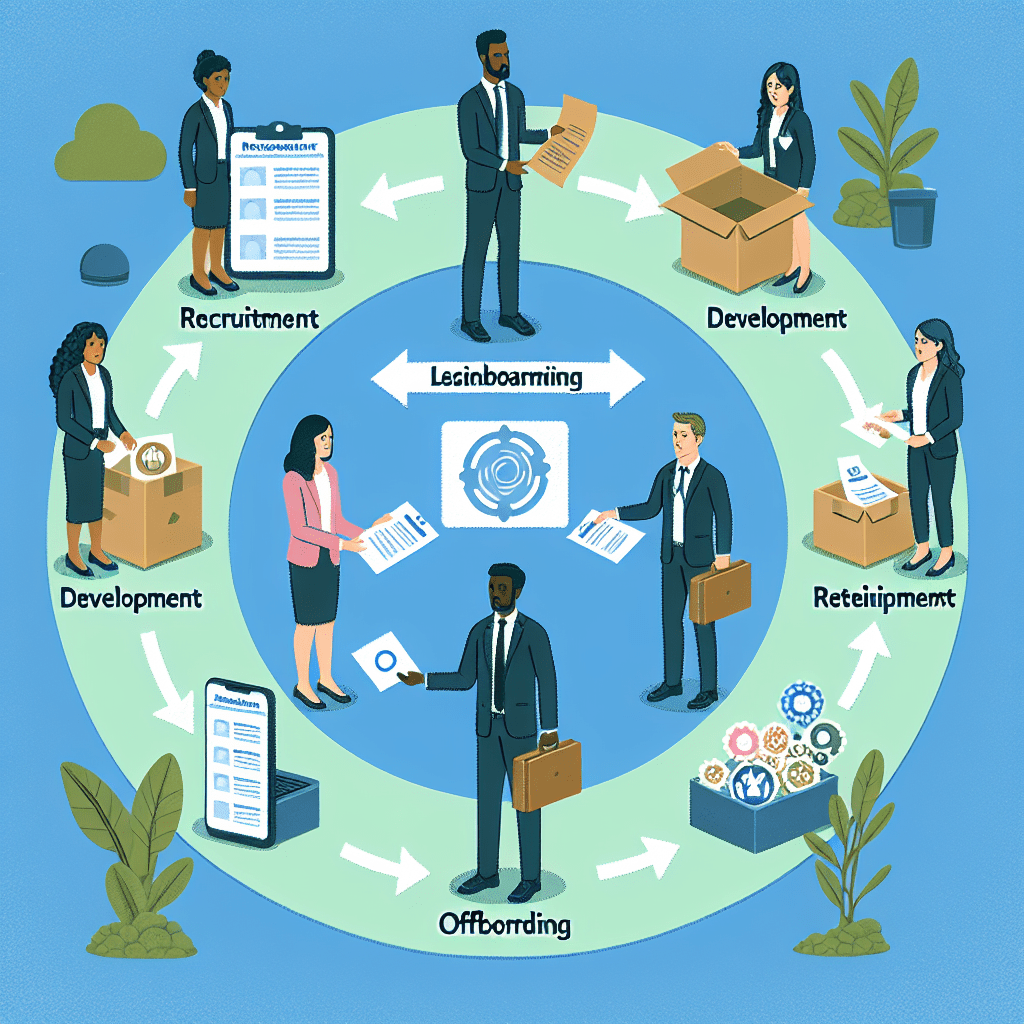-
Table of Contents
Optimize your workforce from hire to retire.
Introduction
Employee Lifecycle Management refers to the comprehensive approach taken by organizations to manage and support their employees throughout their entire tenure, from recruitment to retirement or separation. It encompasses various stages, including recruitment and onboarding, performance management, training and development, employee engagement, and offboarding. This holistic approach ensures that employees are effectively supported, engaged, and developed throughout their journey with the organization, ultimately contributing to their overall satisfaction, productivity, and retention.
Key Challenges and Solutions in Employee Lifecycle Management
Employee Lifecycle Management: Key Challenges and Solutions
Employee Lifecycle Management is a critical aspect of human resources management that encompasses all stages of an employee’s journey within an organization. From recruitment and onboarding to performance management and offboarding, effectively managing the employee lifecycle is essential for organizational success. However, this process is not without its challenges. In this article, we will explore some of the key challenges faced in Employee Lifecycle Management and discuss potential solutions.
One of the primary challenges in Employee Lifecycle Management is attracting and recruiting top talent. In today’s competitive job market, organizations must find innovative ways to stand out and attract qualified candidates. This requires a comprehensive recruitment strategy that includes leveraging various channels, such as job boards, social media, and professional networks. Additionally, organizations should focus on building a strong employer brand and offering competitive compensation packages to attract the best candidates.
Once the recruitment process is complete, the next challenge is onboarding new employees effectively. Onboarding plays a crucial role in setting the stage for a successful employee experience. However, many organizations struggle with providing a structured and comprehensive onboarding program. To address this challenge, organizations should develop a standardized onboarding process that includes orientation sessions, training programs, and mentorship opportunities. This will help new employees acclimate to their roles and the organization’s culture more quickly.
Another significant challenge in Employee Lifecycle Management is performance management. Traditional performance appraisal systems often fall short in providing meaningful feedback and fostering employee development. To overcome this challenge, organizations should adopt a continuous performance management approach. This involves regular check-ins between managers and employees to discuss goals, provide feedback, and identify areas for improvement. Additionally, organizations can implement performance management software to streamline the process and provide real-time performance data.
Employee engagement is another critical aspect of Employee Lifecycle Management that poses challenges for many organizations. Disengaged employees can have a detrimental impact on productivity and morale. To address this challenge, organizations should focus on creating a positive work environment that fosters employee engagement. This can be achieved through initiatives such as employee recognition programs, career development opportunities, and regular communication channels. Additionally, organizations should encourage employee feedback and actively address any concerns or issues raised.
As employees progress in their careers, another challenge arises in the form of talent development and succession planning. Organizations must identify high-potential employees and provide them with opportunities for growth and development. This can be achieved through training programs, mentoring, and job rotations. Additionally, organizations should have a robust succession planning process in place to ensure a smooth transition when key employees leave or retire.
Lastly, offboarding employees can also present challenges for organizations. Whether due to retirement, resignation, or termination, offboarding should be handled with care to maintain positive relationships and protect the organization’s reputation. Organizations should conduct exit interviews to gather feedback and identify areas for improvement. Additionally, they should ensure a smooth transition for departing employees by providing necessary documentation, conducting knowledge transfer sessions, and offering support in finding new employment opportunities.
In conclusion, effective Employee Lifecycle Management is crucial for organizational success. However, it is not without its challenges. From attracting and recruiting top talent to offboarding employees, organizations must navigate various obstacles throughout the employee lifecycle. By implementing the solutions discussed in this article, organizations can overcome these challenges and create a positive and productive work environment for their employees.
Best Practices for Effective Employee Lifecycle Management
Employee Lifecycle Management is a crucial aspect of human resource management that encompasses all stages of an employee’s journey within an organization. From recruitment to retirement, effective Employee Lifecycle Management ensures that employees are engaged, productive, and satisfied throughout their tenure. In this article, we will explore some best practices for effective Employee Lifecycle Management.
The first stage of the employee lifecycle is recruitment. It is essential to have a well-defined recruitment process in place to attract and select the right candidates for the organization. This process should include clear job descriptions, targeted job advertisements, and a rigorous selection process that includes interviews, assessments, and reference checks. By following these best practices, organizations can ensure that they hire employees who possess the necessary skills, qualifications, and cultural fit.
Once employees are hired, the onboarding process becomes crucial. Onboarding is more than just paperwork; it is an opportunity to welcome new employees, introduce them to the organization’s culture, values, and goals, and provide them with the necessary tools and resources to succeed in their roles. Effective onboarding programs include orientation sessions, mentorship programs, and clear communication channels to address any questions or concerns that new employees may have.
After the onboarding process, organizations must focus on employee development and training. Providing employees with opportunities for growth and learning not only enhances their skills but also increases their engagement and job satisfaction. Best practices for employee development include creating individual development plans, offering training programs, and providing regular feedback and coaching. By investing in employee development, organizations can foster a culture of continuous learning and improvement.
Performance management is another critical aspect of Employee Lifecycle Management. Regular performance evaluations help identify employees’ strengths and areas for improvement, set performance goals, and provide feedback on their performance. Organizations should establish clear performance metrics, conduct regular performance reviews, and provide constructive feedback to help employees reach their full potential. Additionally, recognizing and rewarding employees for their achievements and contributions can further motivate and engage them.
As employees progress in their careers, organizations should also focus on succession planning. Succession planning involves identifying and developing potential leaders within the organization to ensure a smooth transition when key positions become vacant. By identifying high-potential employees, providing them with the necessary training and development opportunities, and creating a talent pipeline, organizations can mitigate the risks associated with leadership gaps and ensure continuity.
Lastly, organizations must consider the offboarding process when employees leave the organization. Offboarding should be handled with care and professionalism to maintain positive relationships and protect the organization’s reputation. Conducting exit interviews, providing feedback, and offering support to departing employees can help organizations gain valuable insights and improve their employee experience.
In conclusion, effective Employee Lifecycle Management is crucial for organizations to attract, develop, and retain top talent. By following best practices such as well-defined recruitment processes, comprehensive onboarding programs, employee development initiatives, performance management systems, succession planning, and thoughtful offboarding processes, organizations can create a positive employee experience and drive organizational success. Investing in Employee Lifecycle Management not only benefits individual employees but also contributes to the overall growth and success of the organization.
The Importance of Employee Lifecycle Management in Modern Organizations
The Importance of Employee Lifecycle Management in Modern Organizations
In today’s fast-paced and competitive business environment, organizations are constantly seeking ways to improve their performance and gain a competitive edge. One area that is often overlooked but can have a significant impact on an organization’s success is Employee Lifecycle Management. Employee Lifecycle Management refers to the process of managing an employee’s journey from recruitment to retirement or separation from the organization. It involves various stages, including recruitment, onboarding, development, performance management, and offboarding. Effective Employee Lifecycle Management is crucial for modern organizations for several reasons.
First and foremost, Employee Lifecycle Management helps organizations attract and retain top talent. In today’s job market, attracting and retaining skilled and talented employees is a challenge. Organizations that have a well-defined and structured Employee Lifecycle Management process are more likely to attract high-quality candidates. A well-designed recruitment process ensures that the organization hires individuals who possess the necessary skills and qualifications for the job. Furthermore, an effective onboarding process helps new employees feel welcomed and supported, increasing their engagement and commitment to the organization.
Secondly, Employee Lifecycle Management plays a vital role in developing and nurturing employees’ skills and capabilities. In a rapidly changing business landscape, organizations need to invest in their employees’ development to stay competitive. A comprehensive development program that includes training, coaching, and mentoring opportunities can help employees acquire new skills and enhance their existing ones. By investing in their employees’ growth, organizations not only improve their performance but also increase employee satisfaction and loyalty.
Moreover, effective Employee Lifecycle Management contributes to improved performance management. Performance management is a critical process that involves setting clear expectations, providing regular feedback, and evaluating employees’ performance. By implementing a robust performance management system, organizations can align individual goals with organizational objectives, identify areas for improvement, and recognize and reward high performers. This, in turn, enhances employee motivation and productivity, leading to improved overall organizational performance.
Furthermore, Employee Lifecycle Management is essential for ensuring a smooth and efficient offboarding process. When an employee leaves the organization, whether due to retirement, resignation, or termination, it is crucial to handle the transition effectively. A well-managed offboarding process includes conducting exit interviews, transferring knowledge and responsibilities, and maintaining positive relationships with departing employees. By managing the offboarding process effectively, organizations can protect their reputation, maintain employee morale, and minimize disruptions to business operations.
Lastly, effective Employee Lifecycle Management contributes to a positive organizational culture. A well-defined Employee Lifecycle Management process demonstrates an organization’s commitment to its employees’ well-being and success. It creates a supportive and inclusive work environment where employees feel valued, respected, and empowered. This, in turn, fosters a positive organizational culture characterized by high employee morale, strong teamwork, and a shared sense of purpose.
In conclusion, Employee Lifecycle Management is of utmost importance in modern organizations. It helps attract and retain top talent, develop employees’ skills, improve performance management, ensure a smooth offboarding process, and foster a positive organizational culture. By investing in Employee Lifecycle Management, organizations can enhance their overall performance, gain a competitive advantage, and create a workplace where employees thrive.
Q&A
1. What is Employee Lifecycle Management?
Employee Lifecycle Management refers to the process of managing an employee’s journey within an organization, from recruitment and onboarding to development, performance management, and eventually offboarding.
2. Why is Employee Lifecycle Management important?
Employee Lifecycle Management is important as it helps organizations effectively attract, retain, and develop talent. It ensures a smooth transition for employees throughout their tenure, maximizes their productivity and engagement, and ultimately contributes to the overall success of the organization.
3. What are the key stages in Employee Lifecycle Management?
The key stages in Employee Lifecycle Management typically include recruitment, onboarding, performance management, career development, and offboarding. Each stage involves specific activities and processes aimed at supporting and optimizing the employee’s experience and performance within the organization.Employee Lifecycle Management is a comprehensive approach that focuses on managing and optimizing the various stages of an employee’s journey within an organization. It encompasses activities such as recruitment, onboarding, performance management, training and development, and offboarding. By effectively managing each stage of the employee lifecycle, organizations can enhance employee engagement, productivity, and retention. Additionally, it helps in aligning employees’ goals with organizational objectives, fostering a positive work culture, and ensuring compliance with legal and regulatory requirements. Overall, Employee Lifecycle Management plays a crucial role in maximizing the value and potential of an organization’s workforce.
For effective Employee Lifecycle Management, optimize your HR processes and enhance employee experiences. Streamline recruitment, onboarding, performance management, training, and offboarding. Maximize productivity and engagement throughout the employee journey. Contact us to learn more about our solutions and improve your employee lifecycle management.


